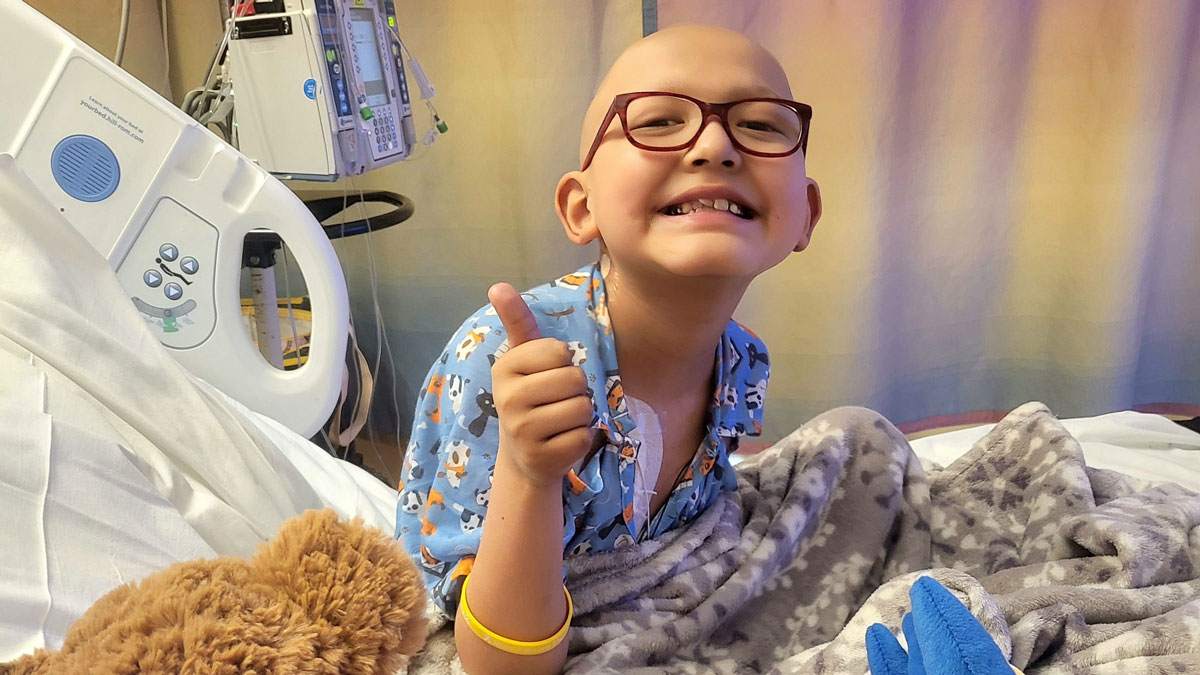
It’s hard to imagine a child calling a hospital—where he underwent chemotherapy and surgery—his “happy place,” but that’s what Lucile Packard Children’s Hospital Stanford is to Josh Summit, age 7. The doctors and nurses are his playmates, and he was sad to leave them.
“Josh sees everyone as his friend, and he brings joy to every situation,” says Michelle Emmons, NP, with Pediatric Oncology. “I was blown away by his ability to stay optimistic rather than get sad or anxious.”

To cope with his serious illness, Josh made a game out of cancer treatment. He became a cat, who would meow loudly to attract visitors to his room to join in on video game tournaments, Wii bowling, or Uno games. He would purr and rub up when he felt happy and safe, and hiss and claw when he had to undergo scary or painful procedures, like blood draws.
“Josh and I quickly became good buddies—his light and positivity were big reminders of why we do what we do on the oncology unit,” says Sam Carletti, PA-C with Pediatric Oncology. “He was an absolute goofball and he was fearless from day one.”
Learning Josh had Ewing sarcoma
One week before Josh was to start first grade, his family learned that he had a very aggressive type of bone and soft tissue cancer called Ewing sarcoma.
“Instead of going to school, he went to the hospital,” says his mom, Amelia.
Josh was having random arm pain that came and went, so his parents took him to see his pediatrician. What they suspected was an overuse injury from a summer full of swimming ended up being something much more serious.
“Things moved very quickly from there,” Amelia says.
Within a week, the family—Josh, his younger sister, Teresa, and his parents, Amelia and Don—were meeting with doctors from the Bone & Soft Tissue Tumors Program at Stanford Medicine Children’s Health. The program provides innovative, coordinated care from multiple specialists, including oncology, radiation oncology, radiology, and pathology.
Ewing sarcoma is a rare cancer. Josh’s sarcoma had started in the soft tissue of his left arm and grown throughout his humerus (the long upper arm bone that runs from the shoulder to the elbow) when he was diagnosed.
“We were lucky to catch it when we did, because it hadn’t spread yet,” Amelia says.
“Ewing sarcoma grows and spreads quickly, putting lives at risk,” says Raffi Avedian, MD, a pediatric orthopedic musculoskeletal tumor surgeon who treated Josh.
Spending a school year in the hospital
Josh was admitted to Stanford Children’s on the spot for what would become nearly an entire school year in and out of the hospital. His treatment plan was intense, starting with three months of chemotherapy, followed by surgery, then another four months of chemotherapy.
Josh spent alternating weeks at the hospital during chemotherapy treatments. The purpose of his first round of chemo was to kill cancer cells and reduce the size of his large tumor. The chemotherapy was strong, so he often felt sick, experiencing nausea, vomiting, and fever. Yet, he never let it get him down.
Undergoing bone surgery for Ewing sarcoma
The next step for Josh was bone surgery to remove the tumor. To make sure he didn’t leave any cancer cells behind, Dr. Avedian removed the top half of Josh’s humerus plus a large portion of his shoulder joint. The complex surgery took over six hours.
“That day is hardest for mom and dad. They put their child’s well-being in our hands, and they have to wait minute-by-minute most of the day,” Dr. Avedian says. “The first thing I noticed when I sat down with the family after surgery was the sigh of relief when they heard it went well.”
Dr. Avedian reconstructed Josh’s shoulder joint and humerus with a state-of-the-art titanium implant that was tailored to match his anatomy and needs. A part of Josh’s recovery was physical therapy to help him learn how to use his new arm, provided by Stanford Children’s expert therapists dedicated to working with kids with cancer.
Tests after surgery revealed the reassuring news that that 100% of the tumor had died. Since Ewing sarcoma so easily spreads, a second round of chemotherapy helped remove any small areas of cancer cells that may have traveled to other parts of Josh’s body, reducing the risk of relapse.
Stanford Children’s becomes Josh’s ‘happy place’
“During Josh’s hospital stay, there was always something—from Luna the robot dog and Mario Kart tournaments to the playground—to take him out of that hospital feeling. That was a big part of his healing process,” Amelia says. “Stanford Children’s is very different than other places. There’s this overwhelming sense of purpose and joy.”

“At Stanford Children’s, it’s a privilege to have so many resources for our patients. We are empowered to create an environment where we don’t just heal children, but also help them grow and develop, and enjoy being kids,” Emmons says.
The team credits Josh’s positive attitude, and his family’s loving support, as big contributors to his good outcome. “The family is fantastic. The way they engaged with the care team brought out the best in us, and their kindness was contagious,” Dr. Avedian says.
To help Josh stay on track with first grade, his mom started a homeschool program through his charter school. He also received support from Child Life and Creative Arts, Social Services, Psychosocial Service, occupational therapy, and physical therapy teams at Stanford Children’s.
“These kids are forced to bear such adult things at a young age, but at the end of the day they still want to be kids,” Carletti says.
Back to school and regular life

While Josh missed his entire first grade in person, he was able to enjoy the summer at home in the Santa Cruz Mountains and return for second grade. The best part was reuniting with his sister, Teresa, and having the whole family together again.
“It was a transition when we left the hospital. He was sad to leave all his friends,” Amelia says. “It’s funny, you have all these people around you at the hospital, and when you go home you’re like, ‘Where’s my support team?’”
Luckily, Josh gets to reconnect with his Stanford Children’s friends at regular follow-up visits, and recent tests show zero signs of cancer. He’s now in the third grade, loving school and playing soccer. Over the summer, the family enjoyed his Make-A-Wish celebration—to be a zookeeper for the day at the San Diego Zoo.
His wish was to care for capybaras. It was no surprise that when asked why he chose that animal, he said, “Because capybaras are friends with everybody.”
Learn more about sarcoma treatment at Stanford Children’s >










